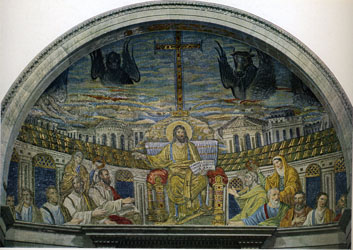

Consider the meaning of the above mosaic in relationship to our discussion of the function of the apse in the basilican architecture. Compare the mosaic to the following quotation from the writings of the Early Christian theologian, St. John Chrysostom:
"You will see the king, seated on the throne of that unutterable glory, together with the angels and archangels standing beside him, as well as the countless legions of the ranks of the saints. This is how the Holy City appears.... In this city is towering the wonderful and glorious sign of victory, the cross, the victory booty of Christ, the first fruit of our human kind, the spoils of war of our king."
Missorium of Theodosius, 388

Let me chant in sacred numbers,
as I strike each sounding string,
Chant in sweet, melodious anthems, glorious deeds of Christ our
King:
He, my Muse, shall be thy story: with His praise my lyre shall
ring.
When the king in priestly raiment
sang the Christ that was to be,
Voice and lute and clashing cymbal joined in joyous harmony,
While the Spirit, heaven-descended, touched his lips to prophecy....
Of the Father's heart begotten,
ere the world from chaos rose,
He is Alpha; from that Fountain all that is and hath been flows:
He is Omega, of all things yet to come the mystic Close.
By His word was all create;
He commands and lo! 'tis done;
Earth and sky and boundless ocean, universe of three in one,
All that sees the moon's soft radiance, all that breathes beneath
the sun....
But, while God with golden glory
floods the murky realms of night,
And upon the startled shadows dawns a day serene and bright,
In the darkened vault of heaven stars forlorn refuse their light.
For the sun in garb of mourning
veiled his radiant orb and passed
From his flaming path in sorrow, hiding till mankind aghast
Deemed that o'er a world of chaos Night's eternal pall was cast.
Now, my soul, in liquid measures let the sounding numbers flow;
Sing
the trophy of His passion, sing the Cross triumphant now;
Sing the ensign of Christ's glory, marked on every faithful brow.
Ah! How wondrous was the fountain
flowing from His pierced side,
Whence the blood and water mingled in a strange and sacred tide--
Water, sign of mystic cleansing; blood, the martyr's crown of
pride.
In that hour the ancient Serpent
saw the holy Victim slain,
Saw, and shed his hate envenomed, all his malice spent in vain;
See! The hissing neck is broken as he writhes in sullen pain.
Christ, our Captain, for a season
deigned to dwell in Death's domain,
That the dead, long time imprisoned, might return to life again,
Breaking by His great example ancient sins' enthralling chain....
Then, mankind to life restoring,
Death downtrodden 'neath His feet,
Lo! The Victor mounts triumphant to the Father's judgment-seat,
Bringing back to heaven the glory by His passion made complete.
Hail! Thou Judge of souls departed:
hail! Of all the living King!
On the Father's right hand throned, through His courts Thy praises
ring,
Till at last for all offences righteous judgment Thou shalt bring....

"Child's Sarcophagus" , 2nd half of the 4th century, Constantinople.
|
|
Venantius Fortunatus in 569 wrote the hymn Vexilla regis prodeunt:
The banners of the king issue forth,
the mystery of the cross does gleam,
where the creator of flesh, in the flesh,
by the cross-bar [of the crucifying cross] is hung.